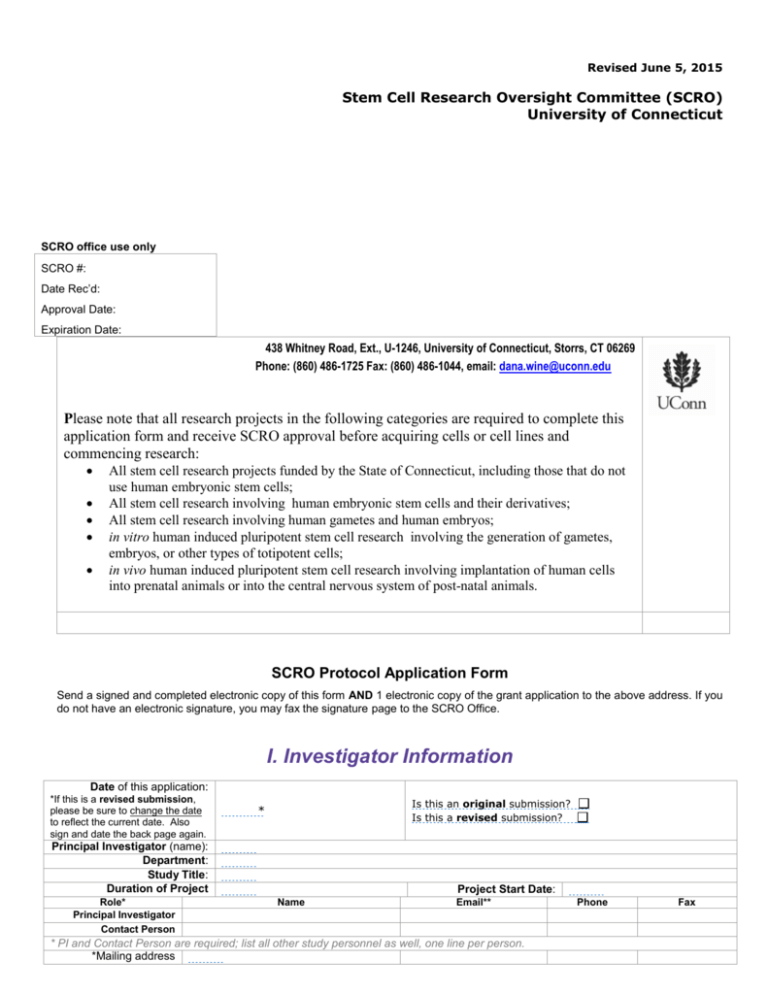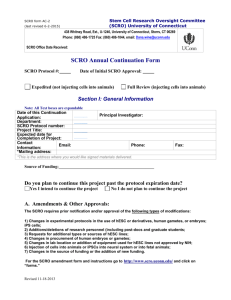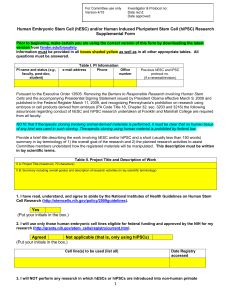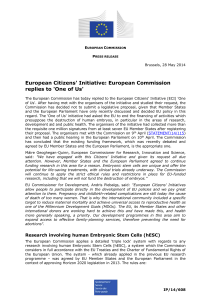Office of Research Compliance, The University of Connecticut
advertisement

Revised June 5, 2015 Stem Cell Research Oversight Committee (SCRO) University of Connecticut SCRO office use only SCRO #: Date Rec’d: Approval Date: Expiration Date: 438 Whitney Road, Ext., U-1246, University of Connecticut, Storrs, CT 06269 Phone: (860) 486-1725 Fax: (860) 486-1044, email: dana.wine@uconn.edu Please note that all research projects in the following categories are required to complete this application form and receive SCRO approval before acquiring cells or cell lines and commencing research: All stem cell research projects funded by the State of Connecticut, including those that do not use human embryonic stem cells; All stem cell research involving human embryonic stem cells and their derivatives; All stem cell research involving human gametes and human embryos; in vitro human induced pluripotent stem cell research involving the generation of gametes, embryos, or other types of totipotent cells; in vivo human induced pluripotent stem cell research involving implantation of human cells into prenatal animals or into the central nervous system of post-natal animals. SCRO Protocol Application Form Send a signed and completed electronic copy of this form AND 1 electronic copy of the grant application to the above address. If you do not have an electronic signature, you may fax the signature page to the SCRO Office. I. Investigator Information Date of this application: *If this is a revised submission, please be sure to change the date to reflect the current date. Also sign and date the back page again. Is this an original submission? Is this a revised submission? * Principal Investigator (name): Department: Study Title: Duration of Project Role* Principal Investigator Contact Person Project Start Date: Name Email** * PI and Contact Person are required; list all other study personnel as well, one line per person. *Mailing address Phone Fax *This is the address where you would like signed materials delivered. Co-Investigator(s) at the University of Connecticut Name Non-University of Connecticut Investigator(s) Email Name Institution Phone Fax Email* Phone II. Scientific Review 1. Has this project been reviewed by an expert scientific panel (e.g. a NIH study group or other form of peer review)? Yes No If yes, please identify the review panel(s). III. Conflict of Interest Does the principal investigator, any co-investigator, or research coordinator involved with this study (or in aggregate with his/her spouse, dependents, or member of his/her household) have a financial relationship with the source of funding that requires filing a University of Connecticut financial disclosure form? *Yes No * If Yes, SCRO will not approve the protocol until the relevant Conflict of Interest Committee (either at Storrs or UCHC) has completed its review. IV. Approvals from other Committees/Offices within the University of Connecticut SCRO Protocol Application Form, Revised June 5, 2015 2 Submit applications to SCRO after or at the same time as application to the IBC, IACUC, or IRB. SCRO will not approve protocols until documentation of all other necessary approvals has been received. The PI is responsible for submitting approval documents to the SCRO. Check all that apply: Other Committees/Offices Pending Approval Approved Protocol Number *Institutional Biosafety Committee Institutional Animal Care and Use (IACUC) **Institutional Review Board * For use of recombinant DNA, any potentially hazardous biological materials, or any biological toxins. ** IRB approval is required for donation of human gametes, somatic cells, embryos, and human biological materials for which the donor can be identified. *** Must be completed prior to release of funds by all PIs and staff working on the project. Contact the SCRO office for the Tutorial. V. Stem Cell Research Activities Check all that apply: 1. Research using human fetal tissue or human embryos at any stage. 2. In vitro research using pre-existing anonymous human embryonic stem cells (hESCs) or their derivatives. Uses federally eligible lines (i.e. lines on the NIH registry http://grants.nih.gov/stem_cells/registry/curren...) Uses federally ineligible lines (i.e. lines not on the NIH registry (http://grants.nih.gov/stem_cells/registry/curren...) 3. Research using human ESCs, human iPS cells, or other human cells that is funded by the Connecticut Stem Cell Research Program. 4. Production of human gametes from hESCs or human iPS cells. 5. Introduction of human ES cells or derivatives into animals. 6. Introduction of hESCs and/or human iPS cells into the central nervous system of animals. 7. Derivation of hESC from donated excess embryos from fertility treatments.* 8. Use of hESCs or human iPS cells to contribute to a human embryo. 9. Creation of human embryos intended for research purposes using SCNT. *** 10. Creation of human embryos from donated human gametes, or from gametes derived from hESC or human iPS lines.** * Requires IRB approval for embryo donation. ** Requires IRB approval for gamete donation and written procedures and practices to protect human oocyte donors. ***Requires refined SCNT techniques that reduce the quantity of required oocytes and requires stringent written policies and practices to ensure that derived embryos are used only for the intended research purpose. VI. Source(s) of Funding What is the source of funding for this project? Check all that apply. Connecticut Stem Cell Research Program Other Connecticut State Funds Federal Funds Private Research Foundation Funds Private Industry Laboratory Start Up Funds Other (indicate source_____________________________________) SCRO Protocol Application Form, Revised June 5, 2015 3 VII. Location of Research Activities and Equipment Use Laboratory space, office space, shared equipment rooms, equipment, and any object that is supported with federal funds may not be used for stem cell research activities that are not eligible for Federal support. Federally eligible stem cell research includes research that is restricted to: (a) the use of nonhuman stem cells; (b) human adult, fetal, or umbilical cord stem cells, (c) or NIH-registered hESC lines and their derivatives. http://stemcells.nih.gov/research/registry/ Federally ineligible stem cell research includes research that: (a) involves non-NIH-registered human embryonic stem cell lines or their derivatives (b) creates human embryos for stem cell research (c) combines hESC with human embryos. Locations of federally eligible research activities and equipment use: Building Name or Service Center Room Number Approximate Start Date Duration of Use for Project Locations of federally ineligible research activities and equipment use: Building Name or Service Center Room Number Approximate Start Date Duration of Use for Project (Documentation: An equipment inventory for all listed rooms is required. Please contact Robin Hoagland for the Storrs campus at 486-3780 or robin.hoagland@uconn.edu. For UCHC contact Julie Schwager at 679-7649 or schwager@uchc.edu.) Does all equipment to be used reside in the locations(s) listed above? Yes *No *If No, please attach list of other equipment to be used along with the location of the equipment. Research Finance must approve and tag all equipment in the space before work on this project may begin and funding released. This process may take 30 days. Other Institutions: List all other collaborating institutions where the research will be conducted. (If you are using human embryonic stem cells at any of these locations, you will need SCRO approval from that institution.) Building Name or Service Center Room Number Approximate Start Date VIII. Human Biological Materials SCRO Protocol Application Form, Revised June 5, 2015 4 Duration of Use for Project Does the research involve human cells/tissues? *Yes *No *If No, you have completed all relevant sections of this application form. If Yes, continue with Section 1. 1. Complete the following table for all human cells/tissues involved with the research: Source (Provide identifying information for all hESC lines, e.g. WiCell H-9) Material human iPS or other Non-Embryonic Derived Human Pluripotent Stem Cells for uses described in section IV. Source/ Provenance 1. 2. 3. MTA/SLA # Quantity (If applicable attach copy of MTA) 1. 2. 3. 1. 2. 3. 1. 2. 3. 1. 2. 3. 1. 2. 3. 1. 2. 3. 1. 2. 3. 1. 2. 3. Source/ Provenance Human Somatic Cells to be used for iPS for uses described in section IV Multipotent Human Neural Stem Cells (if there is the potential that they may contribute to central nervous system of chimeric animals) NIH-Registered hESC lines 1. 2. 3. Source/ Provenance 1. 2. 3. 1. 2. 3. Non-NIH-Registered hESC lines 1. 2. 3. 1. 2. 3. 1. 2. 3. frozen embryos 1. 2. 1. 2. N/A – Requires IRB approval for donation process. fresh embryos 1. 2. 1. 2. N/A – Requires IRB approval of donation process. frozen sperm for uses described in section IV. 1. 2. 1. 2. N/A – Requires IRB approval of donation process. fresh sperm for uses described in section IV. 1. 2. 1. 2. N/A – Requires IRB approval of donation process. frozen oocytes for uses described in section IV. 1. 2. 1. 2. fresh oocytes for uses described in section IV. 1. 2. 1. 2. N/A – Requires IRB approval of donation process. N/A – Requires IRB approval of donation process. 2. Informed Consent for Human Somantic Cell, Gamete, Embryo, and hESC Donors SCRO Protocol Application Form, Revised June 5, 2015 5 2a. Does the research involve hESC lines from sources other than the University of Connecticut Stem Cell Core and which are not listed on the SCRO website as “approved”? (Materials banked in the UConn Stem Cell Core have been reviewed previously for informed consent). *Yes No *If Yes, attach documentation of IRB approval from the institution(s) responsible for the derivation of the stem cell lines. Include specific information about the informed consent process and form. Informed consent is required from the donors of the embryo and all gamete donors. 2b. Do any human somatic cells, gametes, or embryos come from sources other than the University of Connecticut Stem Cell Core? (Materials banked in the UConn Stem Cell Core have been reviewed previously for informed consent). *Yes No *If Yes, attach documentation of IRB approval from the responsible institution(s). Include specific information about the informed consent process and form. Donor informed consent must be in accordance with NAS Guidelines. 3. Donor Confidentiality (IRB approval is needed for protocols using materials with direct or coded donor identifiers that may be accessible to investigators.) 3a. Do any of the materials listed in #1 or #2 have direct donor personal identifiers accessible to investigators or laboratory personnel? (These samples are supplied to investigators from identified specimens with a personal identifier (such as a name, patient number, or HIPAA defined PHI) that would allow the researcher to link the biological information derived from the research directly to the individual from whom the material was obtained). *Yes No *If Yes, indicate the direct identifiers provided with the material and provide justification for retaining the direct identifiers with the material. Describe procedures for maintaining confidentiality. IRB approval is required. 3b. Do any of the materials listed in #1 or #2 have coded donor identifiers accessible to investigators or staff? (Also called “linked” or “identifiable”, these samples are supplied to investigators from identifiable specimens with a code such as “A001” that could be linked back to direct identifiers of the donors). *Yes No *If Yes, describe (a) the process for coding the samples, (b) where the link is stored and its security, (c) the personnel who have access to the links and their training in confidentiality procedures, and (d) what becomes of the coded data and samples when the study is completed. IRB approval is required. IX. Research Plan Summarize your study : To the extent possible, the summary should be written in language intelligible to a layperson. Provide clear and concise statements of research objectives, research hypotheses, study rationale and methodology, and expected results. The length should be at least one half of a page and no more than one page. Benefits: Explain the scientific significance of the expected results. SCRO Protocol Application Form, Revised June 5, 2015 6 State the background information and recent work that support the plan for this project. If hESC lines are used, discuss relevant supporting work already done with animals. If the research involves ethically controversial methods (e.g. creation or destruction of human embryos; research involving human gametes; experiments with the potential for integration of human and nonhuman cells or DNA in animal brains, germ lines, or new pluripotent cells), discuss relevant supporting work that has been done with ethically less controversial methods. Provide references to peer-reviewed scientific publications and data. Background: Proposed experiments: Outline the proposed experiments and their scientific rationale. Clearly present the sequence and projected timeline for the experiments. Chart format is helpful. Special attention should be given to specifying activities for the first year of the study and clearly describing the timeline and scientific rationale for ethically controversial areas of research (e.g. creation or destruction of human embryos; research involving human gametes; experiments with the potential for the integration of human and nonhuman cells or DNA in animal brains, germ lines, or new pluripotent cell lines). SCRO Protocol Application Form, Revised June 5, 2015 7 X. Justification for Use of Pre-existing hESC Lines or Derivatives 1. If the research involves pre-existing hES cells or derivatives, justify the use of hESC lines or hESC derivatives rather than an alternative methodology that uses human adult, human fetal or nonhuman stem cells. Cite supporting peer reviewed scientific journal articles or data. 2. Does the research involve the generation of human gametes or embryos from hESC? *Yes No *If Yes, describe what further work will be done with the gametes or embryos as part of the proposed project and state whether they will be maintained or disposed of when the project is completed. If the generated gametes will be tested through embryo genesis answer section XI. X. Justification for Derivation of New hESC Lines Using Excess Embryos from IVF Fertility Treatments 1. Justify the derivation of new hESC lines by this method. (Why are new lines needed? What will be distinctive about the proposed lines? Are there valid alternatives to creating new hESC lines in achieving the benefits of the research?) Cite supporting peer reviewed scientific journal articles or data. 2. Identify and justify the requested numbers of embryos, showing that the requested number is the smallest necessary to achieve research objectives. Cite supporting peer reviewed scientific journal articles or data. 3. Monitoring of embryo development and use. 3a. Describe the protocols for ensuring that the embryos will be used only for the research described in this application. (If embryos will be banked after completion of the described research, submit a completed banking application form to the SCRO at the time of banking.) 3b. Describe the protocols for determining that an embryo is not suitable for the derivation of stem cells and for disposing of these embryos. 3c. Describe the protocols for ensuring that no embryos develop past day 14 or past the point of primitive streak development, whichever comes first. SCRO Protocol Application Form, Revised June 5, 2015 8 XI. Justification for Creating Embryos for the Purpose of Stem Cell Research (Methods in this category require stringent scientific and ethical justification. They may require external expert scientific review). Check all that apply: Creates human embryos solely for research purposes using IVF. Creates human embryos using parthenogenesis or androgenesis (embryo contains only maternal/paternal chromosomes respectively). Uses somatic cell nuclear transfer with human DNA and animal oocytes. Uses somatic cell nuclear transfer with human DNA and human oocytes. Other (explain): 1. Discuss ethically less controversial alternatives to achieving the same benefits as this study and justify the chosen method. Cite supporting peer reviewed scientific journal articles or data. 2. a. Describe and justify the anticipated number of human oocytes to be used, showing that the number is the smallest necessary to achieve the research objectives. Cite supporting peer-reviewed publications. b. Describe previous experience, research, or innovations that will enable personnel conducting this study to minimize the number of human oocytes. 3. a. Describe and justify the number of embryos to be generated, showing that the number is the smallest necessary to achieve the research objectives. Cite supporting peer-reviewed publications. b. Describe previous experience, research, or innovations that will enable personnel conducting this study to minimize the numbers of embryos generated. 4. Monitoring of embryo development and use 4a. Describe the protocols for ensuring that the embryos will be used only for the research described in this application. 4b. Describe the protocols for determining that an embryo is not suitable for the derivation of stem cells and for disposing of these embryos. 4c. Describe the protocols for ensuring that no embryos develop past day 14 or past the point of primitive streak development, whichever comes first. SCRO Protocol Application Form, Revised June 5, 2015 9 XII. Stem Cell Research Using Animal Models (SCRO approval will not be granted until documentation of all required IACUC approvals is received.) 1. Do any experiments involve the use of animals? *Yes *No *If No, go to section XII. If Yes, continue with this section. 2. Very briefly describe the objectives of any experiments using nonhuman animals. If no experiments in this study implant human cells into nonhuman animals proceed to Section XII. After answering this question. 3. Answer the following questions for each experiment that implants human cells into nonhuman animals. Experiment #1. a. Year(s) in which the experiment will be conducted (e.g. first year, second year): b. Type of nonhuman animal (e.g. SCID mice): c. Type of implanted human cells (e.g. neural progenitors): d. Number of implanted human cells: e. Site of implantation of human cells: f. Developmental stage of animal at time of Implantation: Blastocyst Animals allowed to develop to adult stage: Yes No Embryo Animals allowed to develop to adult stage: Yes No Fetus Animals allowed to develop to adult stage: Yes No Neo –natal Adult Provide the same type of information for any additional experiments. 4. a. Approximately how long will the animals be observed after the implantation of the human cells? b. Will the animals be sacrificed Yes No c. If you answered “yes”, at what point in the study will they be sacrificed? d. Will the animals be allowed to reproduce? Yes No (Note: animals into which hESC or hESC derivatives have been introduced may not be allowed to breed) Note: In most cases the mixing of human and animals cells is regarded as ethically unproblematic from the perspectives of both the public and the SCRO. However ethical concerns exist with respect to two issues: Issue 1. The possible (even though unlikely) migration of human cells to animal gametes. Therefore no animals into which hESC or hESC derivatives are implanted are allowed to breed. Issue 2. Enhancement of animal cognitive abilities due to implantation of human cells, particularly in the context of brain studies. It is believed that the risks of this type of effect increase with increasing numbers of implanted cells, increasing plasticity of the implanted human cells, and earlier developmental stages of the research animal at the time of implantation. Depending on the numbers and types of human cells used and the host’s developmental stage at implantation, PIs may be required to work with the SCRO in developing a risk management plan. Keeping these concerns in mind, please answer the remaining questions. SCRO Protocol Application Form, Revised June 5, 2015 10 5. Describe how you will prevent adult animals from breeding. [Note: any deviation from your plan or unexpected event that increases the risk of breeding must be reported to the SCRO immediately.] 6. With respect to the cell types that you plan to use, what effects do you predict? Cite studies that support your predictions. 7. If you are doing brain studies with hESC or neuro-progenitors: a. In terms of the average numbers of cells normally in the animal’s brain, up to what percentage of the animal’s brain could be constituted by the injected human cells? b. Describe your plan and timetable for monitoring the effects of the human cells, including any behavioral effects. [Note: any unusual or unexpected effects should be reported to the SCRO immediately.] 8. If hESC and/or human iPS cells are introduced into animal blastocysts, embryos, or fetuses, explain why experiments using more developed human cells or animals cannot provide relevant information. XIII. Expertise and Training of Research Staff and Investigators Does the project involve hESC lines, human iPS cells (for purposes in section IV) or derivatives, or the derivation of new hESC lines? * Yes * No *If No, skip the rest of Section XII. If Yes, identify the expertise of all personnel who will be handling hESC, human gametes or human embryos, including PIs, postdocs, and students. Appropriate scientific training with hESC is required prior to working with these materials. All personnel must complete the Stem Cell Finance and Research Compliance Tutorial which is available on the ESCRO website. Attach a bio-sketch in NIH form for each of the personnel listed below (not required for students.) STATUS NAME (e.g. faculty, post-docs, grad students, & staff) PRIOR hESC EXPERIENCE OR TRAINING TASKS USING hESC (e.g. thawing, culturing, running experiments) SCRO Protocol Application Form, Revised June 5, 2015 (give approximate date & source) 11 Stem Cell Finance And Research Compliance Tutorial Date Passed XIV. Storage and Tracking of hESC, Human Gametes, and Human Embryos PI’s are responsible for ensuring that only authorized personnel have access to hESC lines, human iPS cells, human gametes, and human embryos. PI’s should maintain a current registry of all personnel with authorized access to hESC lines, gametes, and embryos. In addition PIs are responsible for maintaining a tracking system of these materials includes current information about the location, use, and users of the materials, as well as the SCRO protocol number and OSP/ORSP number under which the research occurs. 1. Describe the system for ensuring that only authorized personnel have access to the hESC, or human iPS cells, embryos, or gametes both in storage and when in use. [See hESC Lab Policy document] 2. Describe the system for tracking the location, use, and users of the hESC, iPS cells, gametes, or embryos. [See hESC Lab Policy document] 3. Describe the process for disposal of human cells or tissues. 4. Will human cells, embryos, or gametes be maintained after the completion of the research? *Yes No * If Yes, identify which materials will be maintained, and how and where they will be maintained. SCRO Protocol Application Form, Revised June 5, 2015 12 XV. Investigator Certification The following are the minimum responsibilities of Principal Investigators as stated in the formal agreement between the University of Connecticut and SCRO. Check off each item to indicate that you have carefully read and understand your responsibilities. I, the Principal Investigator, certify that I have answered all questions on this document and its attachments truthfully and with appropriate completeness. I, the Principal Investigator, understand that all personnel (researchers and staff) involved with human stem cell research must complete the Stem Cell Finance and Research Compliance Tutorial. I, the Principal Investigator, understand that I must file an amendment form (available on line) for any change in hESC research personnel and that all new personnel must complete the Stem Cell Finance and Research Compliance Tutorial mentioned above. I, the Principal Investigator, understand that research that is ineligible for federal support will be conducted only in space and with equipment that is approved in advance, and that no investigators will conduct hESC research in locations other than as describe above without prior notification to ORSP or OSP and the SCRO Committee. I, the Principal Investigator, understand that I will be required to file an annual report on the stem cell lines in my possession. This will be a part of the UConn Stem Cell Registry. I will also send the SCRO any SLA/MOU/MTAs for cell lines I may receive from approved sources other than the UConn Stem Cell Core. I, the Principal Investigator, agree that I will adhere to the University Stem Cell Lab policies as published on the university’s web site (which includes security measures for all hESC lines for which I have an MTA.) I, the Principal Investigator, understand that no investigators will perform experiments for human reproductive cloning. I, the Principal Investigator, understand that no investigators will allow any human embryo to develop past day 14 or the point of primitive streak development, whichever comes first. I, the Principal Investigator, understand that at this time no investigator will introduce any type of embryonic stem cells or iPS cells into human subjects or human blastocysts, or any hES cells into nonhuman primate blastocysts. I, the Principal Investigator, understand that no investigator will allow an animal to breed into which hESC or hESC derivatives or human iPS cells have been introduced. I, the Principal Investigator, am responsible to notify the SCRO of any amendments to my IBC, ACC/IACUC or IRB protocols relevant to hESC research prior to implementation. In addition, I am responsible to notify the IBC, ACC/IACUC, and IRB of any amendments to my hESC protocols under the jurisdiction of those committees. I, the Principal Investigator, understand that the Offices of Research Compliance at UCHC and Storrs have the right to perform unannounced audits of laboratories involved with hESC. Principal Investigator Signature Date Print Name Signature I agree to comply with the policies listed in the Investigator Certification and any other relevant guidelines from the University of Connecticut and Federal and State agencies. Send a signed copy of this form to dana.wine@uconn.edu or fax to (860) 486-1044. Co- Principal Investigator Signature Date Print Name SCRO Protocol Application Form, Revised June 5, 2015 13 Signature __________________________________________________ I agree to comply with the policies listed above the Investigator Certification and any other relevant guidelines from the University of Connecticut and Federal and State agencies. Send a signed copy of this form to dana.wine@ucconn.edu or fax it to (860) 486-1044. Department Head/Center Director Signature (required unless the grant application/contract is attached) Print Name: Date: Signature: Send a signed copy of this form to dana.wine@uconn.edu or fax to (860) 486-1044, or mail to U-1246, Storrs, CT 06269-1246. SCRO Protocol Application Form, Revised June 5, 2015 14





